Catamaran vs Monohull in Rough Seas: Which is Better?
Catamarans and monohulls have different designs that affect how they handle rough sea conditions. In fact, they have an advantage over each other when sailing in heavy seas. Let's try to compare each type of vessel based on their performance, design, and stability, to help you decide which can give you a safer and more comfortable journey on the open water.
Regarding speed, efficiency, and stability, a catamaran may be the better option for you. Because they have twin hulls, they are more comfortable to sail in rough seas. A monohull can become more advantageous in rough seas when sailing upwind since it can point higher into the wind and can handle strong winds easily.
Catamarans with two rudders also allow for better control and maneuverability in rough seas compared to monohulls, which only have one rudder. Let's look at more of the comparison between these two types of boats when sailing through big waves in the sea.
- When it comes to stability and comfort, catamarans can provide more stability. They are also less likely to cause seasickness and offer more living space and privacy.
- In terms of speed, catamarans are also faster than monohulls because they have a smaller displacement. Their structure also makes them less likely to capsize or sink.
- A monohull is advantageous when it comes to sailing upwind, and handling stronger winds. Their deep keel also provides them with increased stability and reduces drag, which can be an advantage in rough seas.


Catamarans Vs. Monohulls in Rough Seas
If you're planning to buy a boat, and you're deciding whether to go for a catamaran or a monohull, one of the many things you may need to consider is how they perform in rough seas. Rough seas can be challenging for any vessel, but some boats are better equipped to handle them than others. Below is a table summarizing how well these boats perform in rough seas:
| Two hulls connected by a deck | Cruising, chartering, racing | More stable in terms of roll stability | Generally faster and more efficient due to twin hulls | Not as good as monohulls | |
| Only one hull | Day sailing, racing, cruising | Better at handling heavy seas and high winds | Not as fast or efficient due to single hull | Better than catamarans |
A catamaran is a boat with two hulls connected by a deck. Because they have two hulls , catamarans are known for their speed, stability, and spaciousness. They are often used for cruising and chartering, as well as racing. They also have a wider beam than monohulls, which means they offer more living space and stability. They are less likely to heel or tilt to one side, are more buoyant, and have a shallow draft.
On the other hand, monohulls are the most common type of boat with only one hull. They are known for their simplicity, versatility, and affordability. Monohulls are often used for day sailing, racing, and cruising.
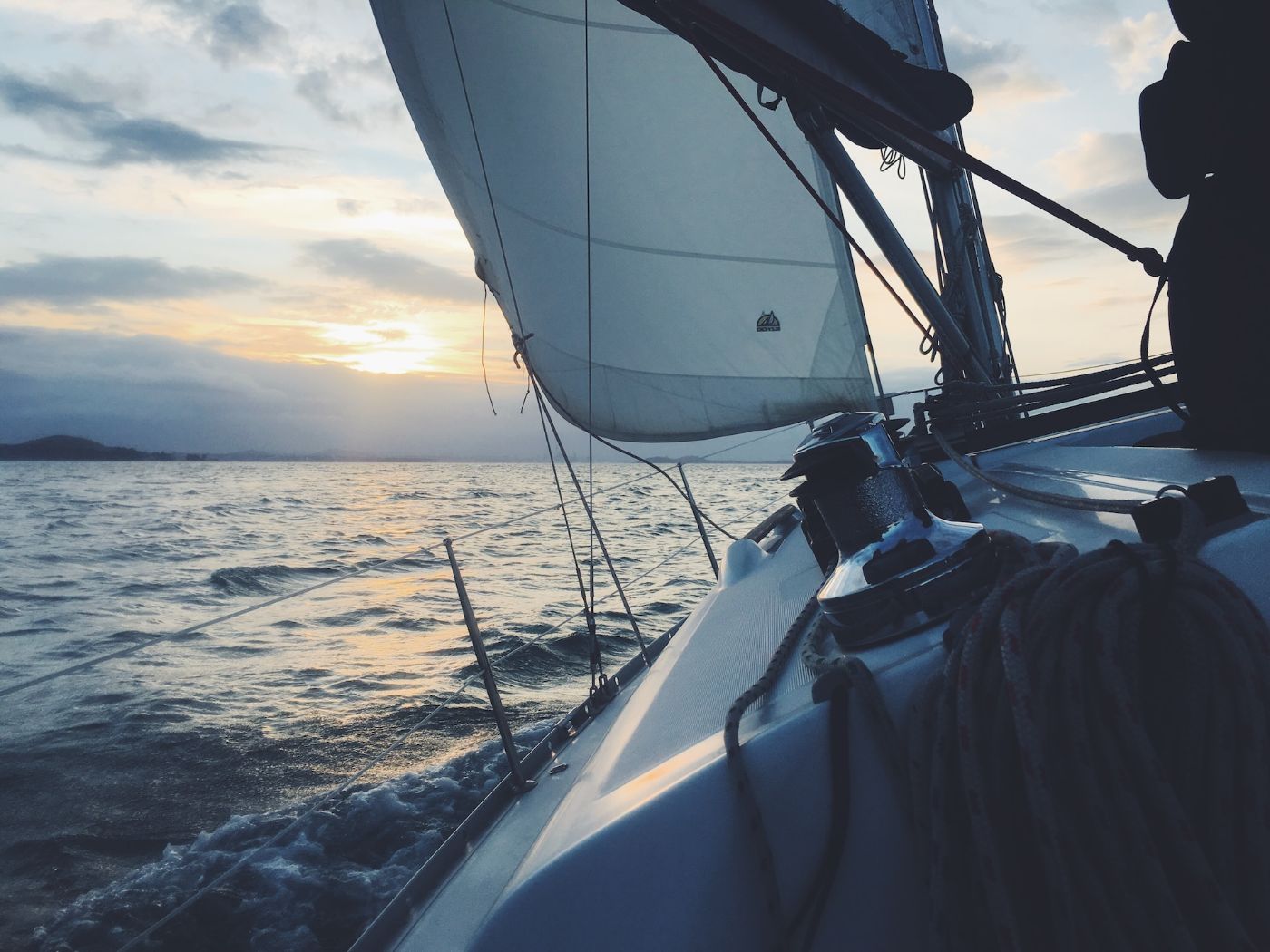
When it comes to rough seas, catamarans are generally more stable than monohulls in terms of roll stability. Monohulls, on the other hand, are better at handling heavy seas and high winds, but they can be more prone to rolling and pitching, and can significantly heel more than a catamaran.
If you are aiming for speed, efficiency, and stability, then a catamaran may be the better option for you. They are generally faster and more efficient due to their twin hulls, and their stability can make for a more comfortable ride in rough seas.
On the other hand, if you prioritize upwind sailing performance, sailing feels and responsiveness, and the traditional look and feel of a sailboat, then a monohull may be the better option for you. Monohulls sail closer to the wind and have a unique feel to them that some sailors prefer.
Detailed Comparison Between Catamaran And Monohull
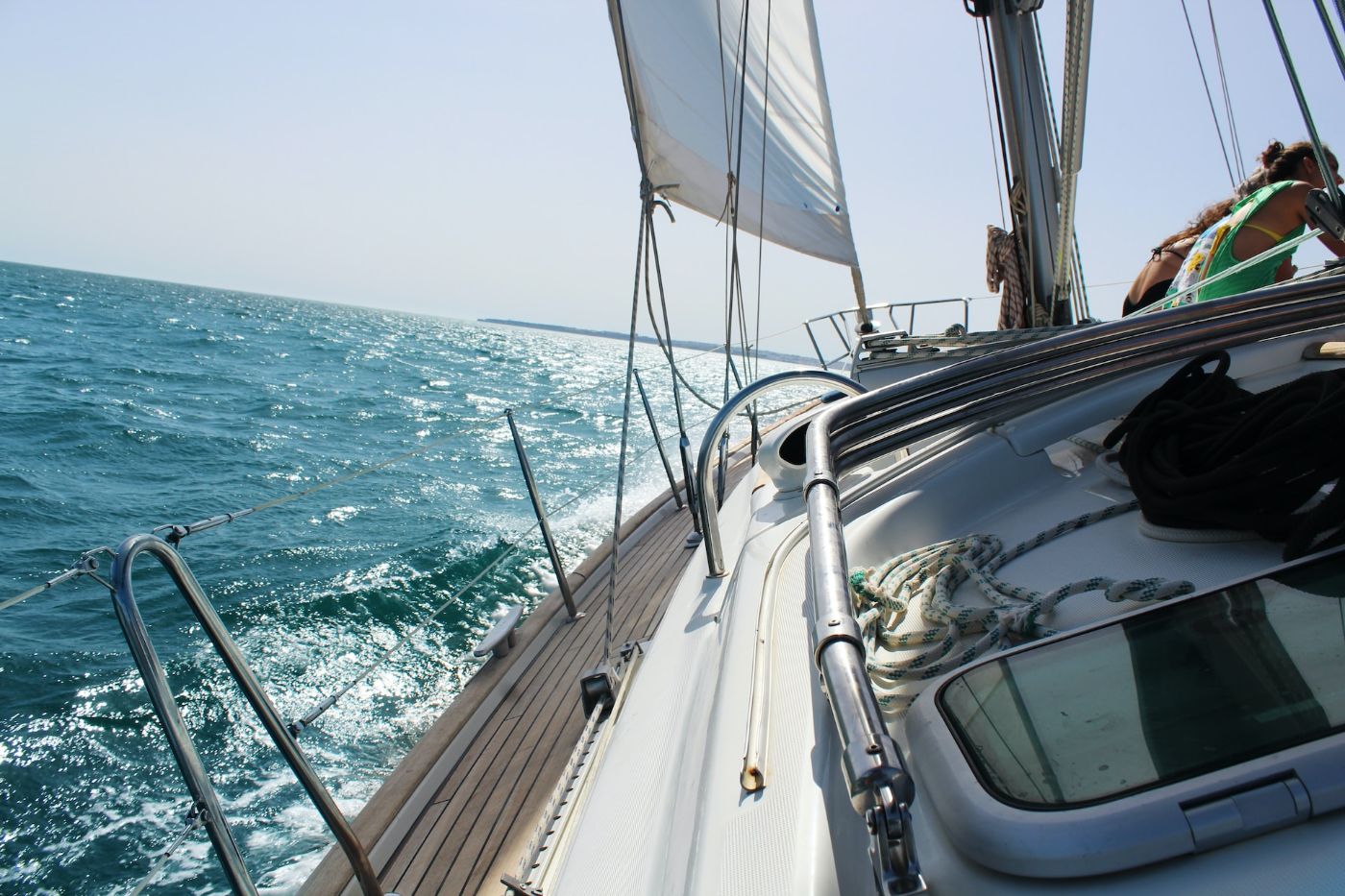
Catamarans provide better stability and comfort
Catamarans are more stable, less likely to cause seasickness and offer more living space and privacy. Below is a table summarizing why catamaran is more advantageous in this category:
| More stable, less likely to roll or heel | More likely to pitch and roll | |
| Less likely to cause seasickness | More likely to cause seasickness | |
| More living space and privacy due to two hulls | Less living space and privacy due to single hull |
In terms of motion in rough seas
Catamarans are more stable in rough seas because they have two hulls instead of one. This means that they are less likely to roll or heel, which can make for a more comfortable ride. Monohulls, on the other hand, tend to pitch and roll more in rough seas.
In terms of handling seasickness
If you are prone to seasickness, a catamaran may be a better choice for you. The stability of a catamaran means that it is less likely to cause seasickness than a monohull. Additionally, the living space on a catamaran is often spread out between the two hulls, which can help to reduce the feeling of confinement that can contribute to seasickness.
In terms of living space and privacy
Catamarans also tend to offer more living space and privacy than monohulls. Because the living space is spread out between the two hulls, each hull can function as a separate living space. This can be especially beneficial if you are traveling with a group of people and want to have some privacy.
Both boat types have specific advantages in performance and speed
A catamaran is generally faster and more stable than a monohull, but a monohull can be easier to handle in certain conditions.
| Less efficient | More efficient | |
| More stable due to wider beam | Easier to handle |
In terms of navigating upwind
When sailing upwind, a monohull has the advantage over a catamaran due to its ability to point higher into the wind. This means that a monohull can sail closer to the wind than a catamaran, which will need to tack more often. However, a catamaran can make up for this disadvantage with its speed. A catamaran can sail faster than a monohull , which can help it to cover more distance in less time.
In terms of handling strong winds
In strong winds, a catamaran is generally more stable than a monohull due to its wider beam. This means that a catamaran is less likely to heel over, making it more comfortable for passengers. However, a monohull can be easier to handle in strong winds due to its ability to reef the sails. By reducing the sail area, a monohull can reduce the amount of wind it catches, making it easier to control.
Catamarans and monohulls have different designs and function
Catamarans offer more deck and cabin space, shallow draft, and increased buoyancy, while monohulls have a deeper draft, reduced drag, and increased stability.
| Has wider beam and two hulls | Has a single hull | |
| Has a shallow draft | Has a deeper draft and keel |
In terms of the deck and cabin space
One of the advantages of catamarans over monohulls is their wider beam, which provides more deck space. This means more room to move around and increased stability, which is important in rough seas.
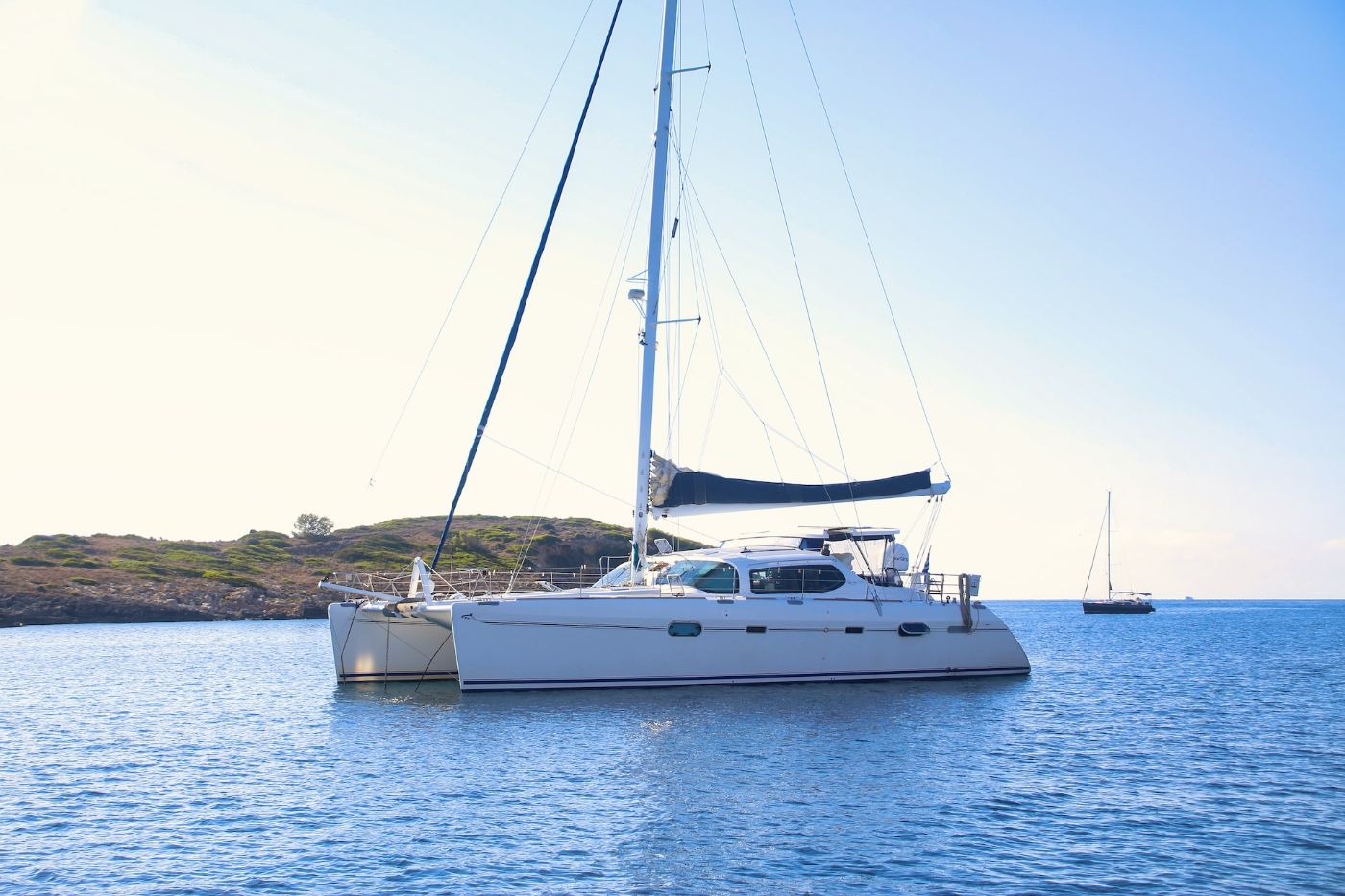
Additionally, catamarans usually have two hulls, which means more cabin space and privacy for the crew and passengers. On the other hand, monohulls have a single hull, which means less deck and cabin space. However, monohulls usually have a deeper draft, which allows them to sail closer to the wind and tack more efficiently.
In terms of draft and buoyancy
Catamarans have a shallow draft, which means they can sail in shallow waters and anchor closer to shore. This makes them ideal for exploring shallow coves and bays. Also, catamarans have two hulls, which provide increased buoyancy and stability in rough seas.
Monohulls, on the other hand, have a deeper draft, which makes them less suitable for shallow waters. However, their deep keel provides increased stability and reduces drag , which can be an advantage in rough seas.
Both boat types have unique safety considerations
Safety is a top priority when sailing in rough seas. Catamarans are generally more stable and easier to control, while monohulls have a greater risk of capsizing but are also more maneuverable in certain situations.
| Less likely to capsize and are virtually unsinkable | Has a keel and ballast that increase the risk of capsizing | |
| With two rudders that provide better control | Only has one rudder and is more susceptible to being pushed off course by waves and wind |
In terms of the risk of capsizing
One of the biggest safety concerns when sailing in rough seas is the risk of capsizing. Catamarans have two hulls, which make them more stable than monohulls. This means that they are less likely to capsize in rough seas. Catamarans are also technically unsinkable , meaning that they will not sink even if one hull is damaged or flooded.
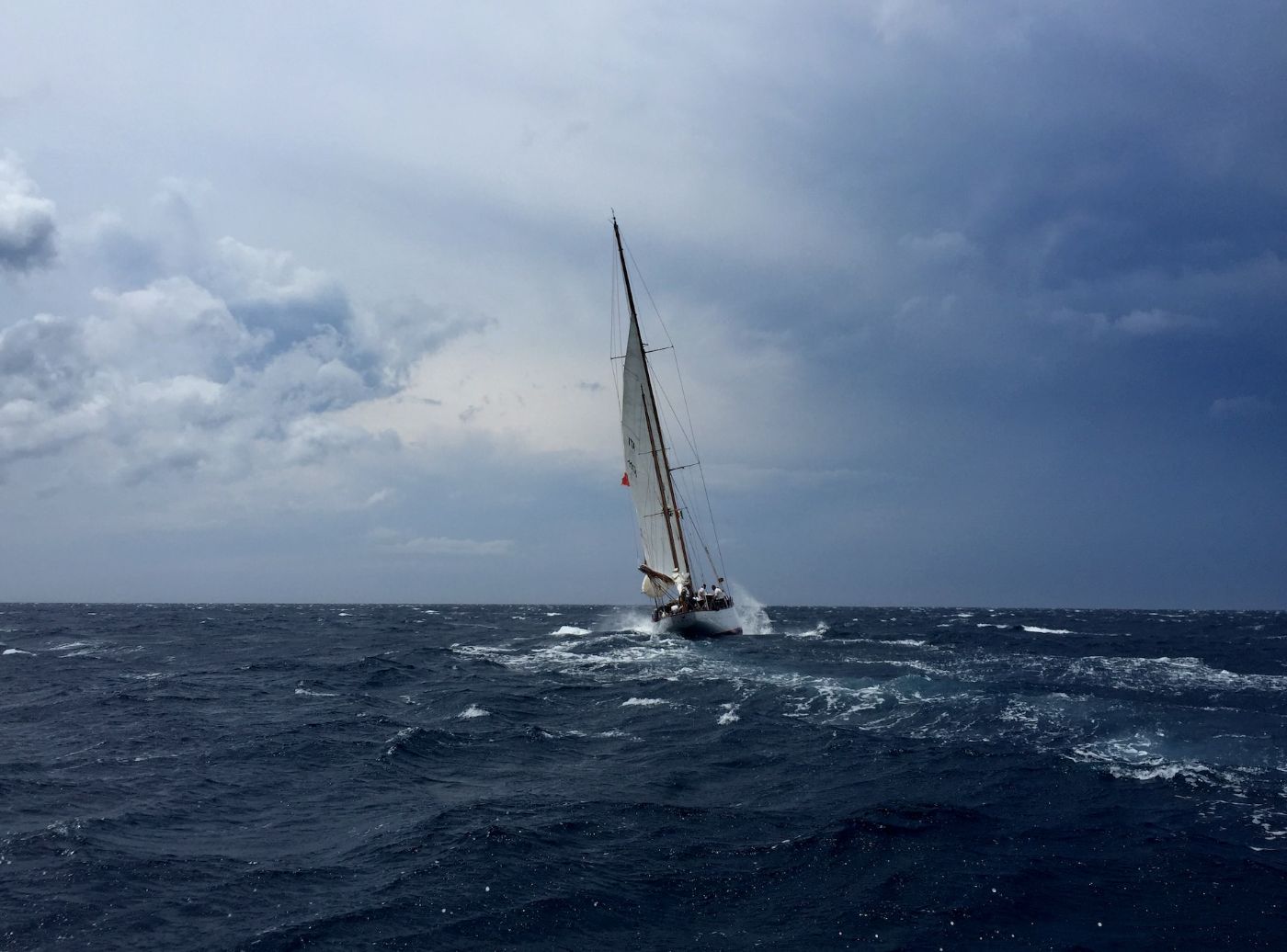
On the other hand, monohulls have a keel and ballast, which provide stability but also increase the risk of capsizing. If a monohull capsizes, it can be difficult to right the boat and prevent it from sinking.
In terms of navigational control
Catamarans have two rudders, which provide additional control and maneuverability in rough seas. This means that you can steer the boat more easily and avoid obstacles like rocks and other boats. Meanwhile, a monohull only has one rudder.
However, despite the number of rudders involved, the ability to control and maneuver the boat, whether a catamaran or a monohull, still depends on the design and construction of the boat, as well as the skill of the captain and crew in handling the boat.
Other practical considerations when choosing between catamaran and monohull
| Docking and anchorage | Easier to dock or anchor but can be more difficult to maneuver in tight spaces due to size | Generally easier to maneuver in tight spaces |
| Storage and equipment | Has more storage space | Only suited for certain types of equipment, such as fishing gear or diving equipment, due to the layout of the boat. |
| Crew accommodations | More spacious accommodations, which can be an advantage for longer trips or larger crews | May offer more privacy for individual crew members due to separate cabins and tighter quarters |
In terms of docking and anchorage
Docking and anchorage can be easier with a catamaran due to the wider beam, which provides more stability. However, catamarans can be more difficult to maneuver in tight spaces due to their size. On the other hand, monohulls are generally easier to maneuver in tight spaces, but they may be less stable in rough seas.
For docking costs, catamarans tend to have higher docking rate costs due to their size and wider beam. Read this article to know more about the costs of docking a catamaran in different locations.
In terms of storage and equipment
Catamarans typically have more storage space than monohulls due to their wider beam and larger deck area. This means they can carry more gear and supplies, making them a good choice for longer voyages or liveaboard situations. They can accommodate larger equipment such as dinghies, kayaks, and paddleboards - making them a great choice for water sports enthusiasts who want to bring their gear along.
Monohulls, on the other hand, have less storage space due to their narrower beam and smaller deck area. This means they are better suited for shorter trips or day sailing, where less gear and supplies are needed. Monohulls may also be better suited for certain types of equipment, such as fishing gear or diving equipment, due to the layout of the boat.
In terms of crew accommodations
Catamarans tend to have more spacious accommodations than monohulls, which can be an advantage for longer trips or when traveling with a larger crew. However, monohulls may offer more privacy for individual crew members due to the separate cabins and tighter quarters.
Catamarans generally have more living space than monohulls so they can offer more room for sleeping, lounging, and cooking, which can be especially beneficial for larger crews or families. They also often have large, open salons and cockpits that allow for easy socializing and entertaining. This can be a great feature for crews who enjoy spending time together.
Monohulls, on the other hand, have less living space than catamarans due to their narrower beam. This means they may be better suited for smaller crews or shorter trips. They often have cabins located closer together, which can make it easier to communicate and work together as a crew, which is a plus for racing or cruising in crowded areas.
Choosing boat type based on personal preferences
In terms of aesthetics and personal taste.
One of the first things that come to mind when choosing between a catamaran and a monohull is aesthetics. Both types of boats have their unique look, and it is up to personal preference which one you find more appealing. Some people prefer the sleek and modern look of a catamaran, while others prefer the classic look of a monohull.
Another thing to consider is personal taste. If you are someone who prefers a more spacious and open boat, then a catamaran might be the right choice for you. On the other hand, if you prefer a more traditional sailing experience, then a monohull might be the better option.
In terms of suitability for families and couples
Basically, catamarans are known for their stability and spaciousness, making them a great choice for families with children or couples who want to have more space and privacy.
Monohulls, on the other hand, might not be as spacious as catamarans, but they offer a more traditional sailing experience. If you are a couple or a small family who wants to experience the thrill of sailing and doesn't mind being in close quarters, then a monohull might be the right choice for you.
Leave a comment
You may also like, cost of catamaran vs. monohull: which is more expensive.
The market for monohull sailboats is a lot bigger than that of catamarans, which is one of the reasons why they are so much cheaper.
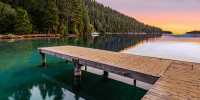
How Much Does It Cost to Dock a Catamaran? (7 Locations)
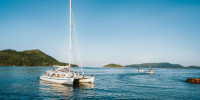
The Perfect Size Catamaran to Sail Around the World

17 Sailboat Types Explained: How To Recognize Them
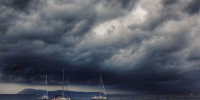
What Type of Hull Handles Rough Water the Best?

9 Best Power Catamarans For Rough Seas and Coastal!
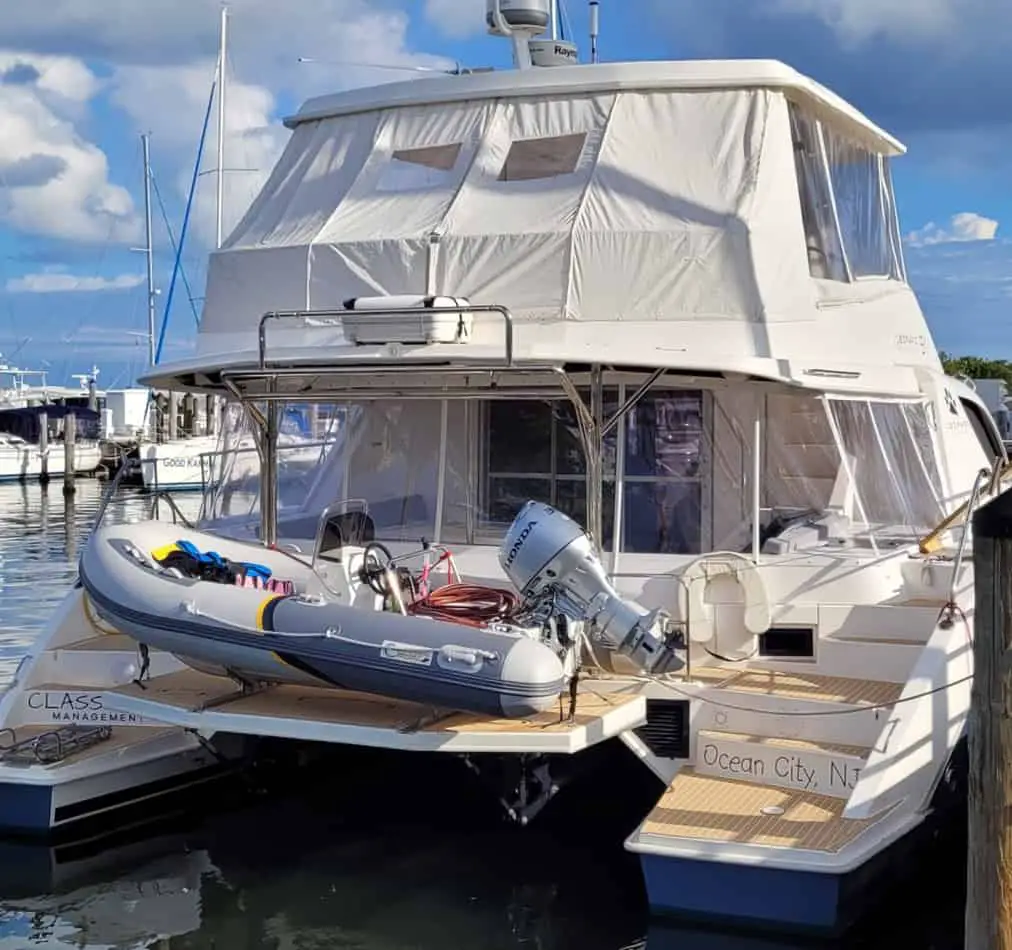
As an Amazon Associate, we earn from qualifying purchases. We may also earn commissions if you purchase products from other retailers after clicking on a link from our site.
Power catamarans are gaining popularity in the cruising world thanks to their enhanced stability and ease of operation. They’re ideal for coastal cruising but can also be used for ocean crossing thanks to their stability and speed.
Here are some of the best power catamarans on the market:
- Fountaine Pajot MY6
- Nautitech 47 Power
- Horizon PC74
- Lagoon Seventy 8
- ArrowCat 420
- Sunreef Supreme 68
In this article, I’ll review some of the best power catamarans out there. I’ll also go over the main features of different power cats and if they can handle rough weather.
But before we dive in, let’s get a better understanding of what power cats are.
Table of Contents
What Is a Power Cat?
A power catamaran (power cat) is a motor-powered boat that, unlike traditional boats, has two hulls connected by a bridge deck. These vessels are more stable than monohulls because of their wide base.
Power cats also don’t have a leaded keel to weigh them down, so they’re pretty lightweight and fast. The lack of a keel also means that power cats are more suitable for shallow waters.
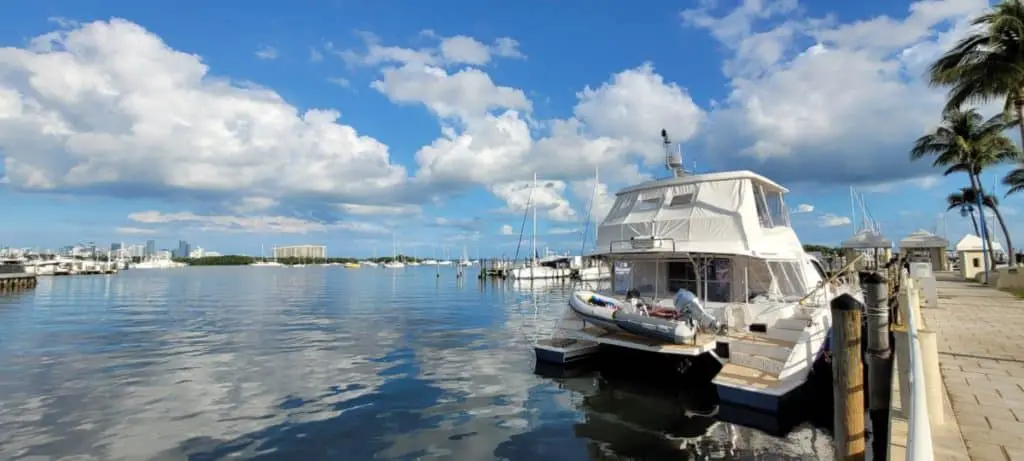
They feature large engines designed to handle their bigger bodies and weights, and serve different purposes, like fishing, cruising, or crossing rough seas. In addition, each hull has a separate engine which makes them more maneuverable, especially at turns and tight spaces.
Power catamarans don’t have sails or masts and get all of their power from the combustion engine (or electric motor), unlike their sailing cousins. In addition, these vehicles are much easier to steer because of their increased stability.
Power catamarans have more interior and exterior space thanks to their multihull design, making them perfect for cruising and liveaboard . They also have ample space for storing everything you need on a cruise without worrying about weighing it down. Catamarans offer increased privacy as well because each hull houses one sleeping area, separated by the living area between them.
Are Power Cats Good in Rough Water?
Power catamarans are good in rough waters particularly because of their multi-hull design. Their wide base makes them stable, and their high speed allows for outrunning bad weather.
Power cats that feature a high bridge clearance, will handle rough waters effortlessly. With the added height, you won’t experience pounding and slamming even in heavy waves, allowing the crew to easily control the vessel in challenging situations.
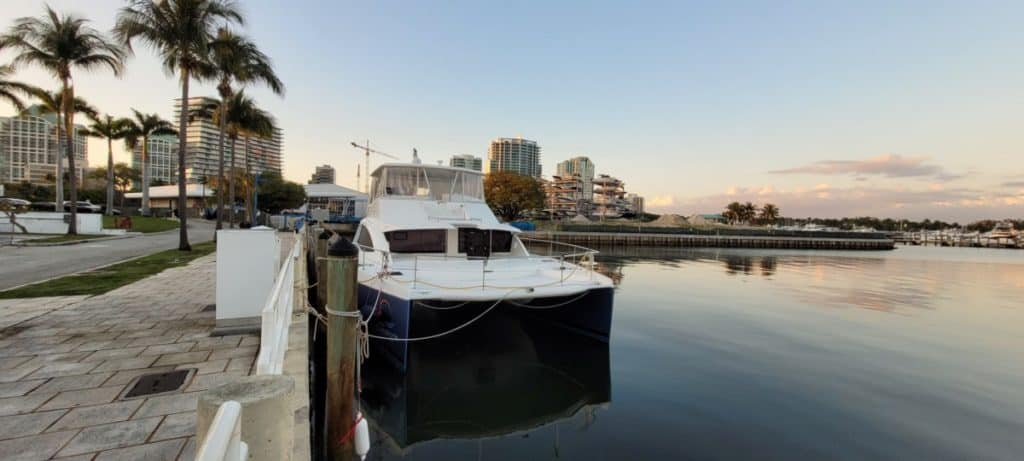
These boats are also faster than their sailing counterparts, which means they can get you out of rough waters quickly.
In addition, since catamarans are large and tall, maneuvering is easier because you have a better view of the surroundings. Additionally, you can steer from the interior cockpit (on certain models), making it easier to control the vessel in bad weather.
Finally, although a power cat doesn’t have a keel to help it right itself in case of capsizing, it will still float easily because of its positive buoyancy.
Are Power Catamarans More Efficient?
Power catamarans are more fuel-efficient than monohulls because they don’t have leaded keels. While keels are designed to offer stability by weighing down the vessel, they increase the wetted surface and thereby add drag.
Due to the catamarans’ narrow bow entry, there’s lower resistance, leading to smoother acceleration and greater fuel economy in catamarans. In addition, power cats show fewer spikes in fuel consumption in a single power band, especially because of their smooth acceleration and fuel consumption.
The figures reported by cat owners or manufacturers show that power cats have the best power-consumption-to-speed ratios.
That being said, you can improve fuel efficiency by maintaining lower speeds; studies have shown that speed can be the most important factor in fuel efficiency, regardless of the number of engines or hull types.
Now that you have a better understanding of power catamarans, let’s take a look at the ten best models on the market.
1. Leopard 53
This 53ft (16.19m) power cat is the fourth generation of the widely popular Leopard catamarans, and brings with it all the great features from her predecessor, the 51.
Although the 51 was the company’s best-selling cat, they added these features to the 53 along with new ones to repeat its success. For example, they have built an enormous saloon, flybridge, and galley by removing the foredeck cockpit in the 51 PC, making it 30 percent larger than the previous model.
This model comes with three or four stateroom layouts, with the 3-stateroom version featuring an owner’s stateroom, two sinks, a loveseat, and lots of storage space.
With two Yanmar 370 hp engines, a maximum speed of 22 knots, and a cruising speed of 17.5, you can enjoy a magnificent ride, whether it’s long-distance cruising or a fun night out with friends.
2. Fountaine Pajot MY6
This luxury power cat is 44ft (13.40m) long, making it super spacious and suitable for families and big parties. With its spacious flybridge, sunbathing lounge, and enormous galley, it’s nothing short of a second home on the water.
You can steer the cat from the saloon or the 21sqm (68 sq ft) flybridge which features a sunbathing lounge, a pool, and a galley.
This motor yacht continues to delight with its luxurious combination of privacy and pleasure, with views of the sea in almost every interior space. With three cabins, two bathrooms, six cabin beds, ample storage, and a kitchen that opens into the cockpit, you can enjoy practicality and luxury in one place.
The MY6 is exceptionally seaworthy and stable thanks to its wave-piercing hulls and Volvo IPS engines.
Like all power cats, it has straightforward steering, enabling you to control this beast even in the roughest circumstances.
3. Nautitech 47 Power
Powered by dual Volvo Penta D4 engines, this model can output 225-300hp, reaching a maximum of 22 knots and a cruising speed of 18-20 knots . This 46′ 8″ (14.23m) long power cat comes in three or four cabin versions, depending on the customer’s preference.
No matter which layout you choose, you’ll get a spacious, luxurious, and comfortable catamaran with panoramic views from the cabin. The sleek, streamlined exterior design ensures elegant sailing and seaworthiness.
It’s easy for passengers to navigate the deck thanks to its seamless design that connects the saloon to the cockpit and the rear deck. The stern features a big swimming platform that can also accommodate a tender. The cockpit is usable in different weather conditions thanks to the clear covers wrapping the whole area.
This efficient catamaran promises long cruising for big families and groups with two 300L water tanks and a pair of 645L fuel tanks.
4. Horizon PC74
The Horizon PC 74 is another luxury power cat that can give you the comfort of your home on water. This 73′ 9” (22.48m) long power cat with a 2,000gal (7570L) fuel tank is an enormous vessel that can accommodate more than 14 people.
The enormous hardtop on the three-piece windshield, the teak dining table, the U-shaped bar, the sun pad, and the swing-out stools all guarantee that you’ll have the luxury cruising experience of a lifetime.
This vast and wide catamaran allows you to access the aft deck from the flybridge via a curving staircase. The vast aft deck has a ten-person dining table, a wet bar, and storage space. You can separate the interior and exterior spaces through sliding glass doors and make the space appear bigger by opening them.
Reaching a top speed of 23 knots and a cruising speed of 19 knots, this enormous catamaran was built for efficiency and practicality.
5. Lagoon Seventy 8
This 78’1″ (23.80m) power cat with two 494 HP engines and a 2246gal (8500L) fuel capacity is one of the largest power cats on the market, offering both comfort and reliability. The enormous flybridge can feature a jacuzzi, a sunbathing area, a large foldable dining table, and a hardtop with a moveable roof. However, you can customize the flybridge based on your preferences.
The designers have compromised nothing in terms of elegance and high-quality materials with top-of-the-line finishes and interior paneling to create the kind of luxury you want.
The saloon is huge, well-ventilated, and separated from the exterior by glass doors and panoramic windows.
But what sets Lagoon Seventy 8 apart from other power cats, in addition to its enormous size, is the wide choice of layouts. You can choose between five different versions, all offering the same amount of storage space, living and sleeping area, and privacy.
Additionally, some versions are fully customizable, allowing you to pick every detail to your liking.
6. ArrowCat 420
This 41′ (12.73m) long express cruiser is a semi-custom catamaran with two-stateroom and three-stateroom layouts. The ArrowCat 420 is designed and built with comfort and strength in mind, and capable of handling rough waters safely.
The two Suzuki 350 hp engines give this model a maximum speed of 40 knots and a cruising speed of 20 knots.
The streamlined design and the angled hulls ensure the vessel cuts through the waves effortlessly, making it easy to maneuver.
The fully-equipped head features an electric toilet, a shower, sink, and mirrors, coupled with a dining table, floor storage locker, and teak-finished floors. This cat is built to combine luxury and comfort for both onshore and offshore cruising.
7. Bali 4.3
This 43′ (13.1m) power cat is made for ocean crossing in mind. With five different layouts featuring different combinations of cabins and heads, the company ensures you’ll get the kind of setup you want. Regardless of the layout, this cat offers a spacious master suite with a large double bed and other private sleeping quarters.
You can quickly add to the overall space by removing the adjustable glass doors to merge the cockpit with the saloon.
A feature that sets the 4.1 apart from its predecessor is the fixed aft deck between the hulls, which provides a passageway and eliminates the need to go from one hull to the other without entering the cockpit.
8. Sunreef Supreme 68
According to its designers, this model was built with a radical concept in mind while staying true to the company’s promise of building the most comfortable and spacious power cats in the world.
One of the greatest features of the Supreme 68 is its aft garage that houses a 5m (16 ft) tender and two jet skis in addition to other water toys.
You can also transform the aft to a large platform for water sports by lowering the garage door.
The four-stateroom layout features ample storage, ensuite guest cabins, queen-sized beds, and TVs to create a memorable stay. The white and beige furniture with chrome details and floor-to-ceiling glazing create a soothing atmosphere that blends with the practicality of the well-equipped galley.
However, if you’re looking for something different, you can opt for a customized model from three different layouts.
9. Hudson 48
The sleek, diamond-cut design of this 46.46’ (14.16m) long power cat is usually the first thing to catch your eye.
It’s a light displacement cat that ensures fast cruising with a top speed of 24 knots and cruising speed of 8 knots thanks to the two 370hp Yanmar V8 engines.
The three-cabin layout features a master stateroom with a spacious and well-ventilated design made possible via the three overhead windows and opening deck hatches.
The saloon’s enormous helm station allows for comfortable and safe accommodation, making it great for rough waters and bad weather conditions.
This model also offers a few entertainment options with its large TV systems and mood lighting. The storage areas and the full-sized walk-in wardrobe give this model a comfortable, homely setting.
Here are Some of My Favorite Catamaran Cruising Resources
Thank you for reading this article. I hope you found it helpful as you hopefully start your sailing adventures. Here are some resources that I use as a sailor that I hope you’ll also find helpful. These are affiliate links, so if you do decide to use any of them, I’ll earn a commission. But in all honesty, these are the exact things that I use and recommend to everyone, even my own family. Sailboats: If you’re looking for the best boat to suit your needs, I would recommend a catamaran. If you’re interested, I can show you the differences between catamarans and other types of sailboats .
Books: For getting started, I really like Cruising catamarans made easy . It is actually a textbook from the American sailing association; it is used to get a cruising catamaran certification. There are some other great books, and I have compiled a list of books about cruising catamarans that you will find useful.
Communication: Being out on adventures, whether it be sailing or climbing mountains, good communications are essential to being safe. I recommend two things Google fi (incredibly simple cellular data all over the world) and Garmin inreach mini (for text and voice in remote areas without cell coverage)
Sailing courses: Online sailing courses are great for beginners starting out their sailing career; it’s an efficient way of learning the basics of navigation, throttle controls, and maritime safety. I suggest starting with two free courses from NauticEd .
To see all my most up-to-date recommendations, check out this resource that I made for you!
Owner of CatamaranFreedom.com. A minimalist that has lived in a caravan in Sweden, 35ft Monohull in the Bahamas, and right now in his self-built Van. He just started the next adventure, to circumnavigate the world on a Catamaran!
Leave a Reply Cancel reply
Your email address will not be published. Required fields are marked *
Save my name and email in this browser for the next time I comment.
Recent Posts
Must-Have Boat Gear for Catamaran Sailors!
Sailing is probably the most gear-intensive activity I've ever done; there are so many decisions to be made about what gear to buy now, for tomorrow, and what to definitely never buy. The gear on...
6 Best Trailerable Trimarans For Bluewater and Coastal Sailing
Having a boat costs a lot of money, even when you are not using it, marina fees, etc. And once it is in the water most sailors never go very far from their "home marina" and sailing will be somewhat...

Are Catamarans Good In Rough Water?

Catamarans are comfortable and offer large and comfortable living spaces, making them ideal for longer trips. But are catamarans good in rough water?
Yes, catamarans are good in rough water. One of the reasons for this is that boaters have the option to steer from the inside during bad weather. What's more; the size, bridge, and bridge clearance all contribute to catamarans being a joy to drive when the water conditions are less than ideal.
Due to the width of the catamaran, you can have a large dinghy with a powerful engine, which is always good to get through rough waters. However, other factors also need to be considered when navigating your catamaran through rough waters.
As experienced sailors, we're quite baffled by the myth that catamarans can't handle rough waters. Having sailed these wonderful vessels for years, here, we're going to put these myths to rest. Let's get started.
Table of contents
Sailing Catamarans
In essence, we need the same sailing abilities as any other sailing boat to sail a catamaran. A catamaran, on the other hand, is considerably easier to manage. As a keel sailing yacht, a catamaran may sail close to the wind. The drawback is that the drift is substantially greater, owing to the lack of a deep keel (only while sailing upwind).
Another major factor that sets the catamaran apart from the rest is that it is quicker in half and heavy breezes (and certainly more comfortable). The helmsman aboard a catamaran can do all sailing movements by himself because all essential lines are channeled to the helm. However, if the sailor requires further assistance, they also have the option of an autopilot function for some extra assistance. This is a great feature to have, especially when trying to navigate through rough waters.
In comparison, monohulls are more difficult to sail than catamarans because they heel significantly more, and they have less room and comfort in the cockpit. This is one of the reasons why sailing in a heeling boat is more difficult. Catamarans, on the other hand, do not heel. You can easily move around the boat because of its added stability and space. As a result, catamaran boats are thought to be "easier" to sail.
A catamaran differs from a monohull in that it has TWO hulls, two motors, and two rudders. When comparing the two types of boats, a catamaran's engines and rudders are spaced far apart, making navigating easier (particularly in tight situations like within the marina) than the single-engine monohull.
The good news for those who are thinking about getting a catamaran is that while some folks think that learning to operate a power catamaran is just too tough and that they will never get used to maneuvering a cat, the truth is that catamarans are extremely easy to control once you get the hang of it. They certainly have a lower learning curve as compared to monohulls.
In fact, cats are considered to be very easy to handle by experienced boaters. Once you understand the basics of keeping a correct trim, you'll be 90% of the way to being an expert. Experienced boaters would tell you that learning to sail a catamaran was simple and that they find it better than sailing a monohull, which only shows just how good catamarans are for sailing or when navigating through rough waters.
Advantages of Catamarans
Because a catamaran has two separate hulls, it has an extremely little possibility of sinking totally. If one hull is damaged or leaks, the other hull will float. A catamaran, on the other hand, cannot lose its keel and will not capsize readily. However, if it capsizes, it will not be able to right itself. Even if a catamaran capsizes, it will float.
Catamarans also have the advantage of duplicating several essential navigation systems that are crucial for onboard safety, making it easier to control the catamaran even with minimal resources. For instance, it is possible for boaters to still sail and steer using a rope or net in the propeller if the engine is damaged. Additionally, when one of the rudders on the catamaran fails, sailors can still steer by using the other rudder and the engines.
One of the main difficulties that boaters face when navigating through rough waters on a catamaran is the risk of falling overboard. This issue is solved with the catamaran because these boats are designed with a wider gangway that does not have any obstacles in the way, which makes it easier to walk up and down the boat.
Also, since the catamarans are known for not tilting easily while sailing, even through rough waters, the risk of going overboard is lowered dramatically as compared to monohulls.
One of the biggest myths that monohull salesmen tell potential power catamaran buyers is that they will be flung off the boat if they need to turn quickly at high speeds. While catamarans do lean slightly outward at moderate speeds and in slow spins, the effect is so modest that no one is at risk of falling into the sea.
The twin-hull design provides for a smooth drift in beam seas. That's because catamarans are designed to settle considerably faster as compared to monohull designs. This is mainly because they do not suffer from the pendulum effect that a monohull does. After all, every movement has an opposing edge.
Some believe that the dual hull design's fundamental flaw is that the two hulls compete for dominance in the catamaran, both tugging in different directions. But, this could not be farther from the truth. Despite the fact that catamarans have a different design than monohulls, with their own unique handling, learning to drive a catamaran is far easier than learning to drive a conventional boat.
Catamarans, as opposed to monohulls, perform better in head seas because of their twin-hull configuration. The key is hidden in the tunnel. Between the tunnel and the water, the air is trapped, producing a cushion of air for the boat to ride on, giving you the finest ride possible.
Factors that Make Catamarans Easier to Navigate on Rough Waters
The length of the blue water catamaran is crucial in resisting strong winds. Longer cats move more easily, are more maneuverable, and are naturally heavier. Strong winds can readily toss the boat about if its length is proportional to its other dimensions.
Most cat aficionados think that a catamaran should be at least 40 feet (12 meters) to keep its stability in rough waters. The optimal length-to-width ratio is 45 to 22 feet (13.72 to 6.71 meters). Because it has greater capacity, a larger boat can carry more weight, and you may arrange your goods in a more ordered manner. This also makes it much easier to handle them in an emergency. It is also important to note for beginners that a heavy-weight boat (lead-filled keel monohull) will move through the waves, but a light vessel will go up and over them.
Bridge Clearance
The distance between the hulls is referred to as bridgedeck clearance. The cat's capacity to manage turbulent waves in a pleasant and safe manner is determined by the bridgedeck height. The high bridgedeck clearance allows waves to flow freely between the hulls.
When there isn't enough bridgedeck clearance, sailing in strong waves produces slamming and pounding that more experienced boaters are familiar with. The pounding might lead to tiredness among the crew and a loss of speed. Furthermore, it will result in increased wear and tear on the gear and equipment. When the boat is heavily laden, the bridgedeck clearance will be lowered.
As a result, the taller it is, the more freedom you have when it comes to filling your boat with gear, water, and gasoline. The pounding under rough circumstances may be unpleasant for both the boat and the crew. Although bridgedeck height is more of a comfort-related consideration, the pounding under rough conditions can be stressful for both the boat and the crew.
When compared to monohulls, one of the benefits of a cat is its incredible stability on the water. This is the case regardless of the type of catamaran you go for and ensures that you are always going to get the highest level of stability while out on the water. Thanks to the boat's multi-hull structure, it will be more stable, with no more heeling.
Even in strong waves, catamarans experience less rocking and rolling, making the crew more comfortable and assisting them in dealing with the situation. The crew's ability to steer the vessel in harsh weather is influenced by fatigue and even seasickness. Catamarans, unlike monohulls, do not have a ballast or lead-filled keels. As a result, their stability is entirely dependent on their broad beam and buoyancy.
It pays to make sure that you stay as far away from harmful situations as possible at sea. This is where catamarans make a good option, mainly because a high-speed catamaran can help you get out of a sticky situation more quickly. To avoid such terrible weather, weather monitoring and smart routing are required. It is important to note that displacement is a critical component that influences speed in a catamaran. The good news is that light displacement is common in contemporary cats, resulting in lower hull drag and increased speed.
Related Articles
Are Catamarans More Stable?
Are Catamarans Easier To Sail?
Are Catamarans Safe For Ocean Crossing?
Jacob Collier
Born into a family of sailing enthusiasts, words like “ballast” and “jibing” were often a part of dinner conversations. These days Jacob sails a Hallberg-Rassy 44, having covered almost 6000 NM. While he’s made several voyages, his favorite one is the trip from California to Hawaii as it was his first fully independent voyage.
by this author
Learn About Sailboats
Most Recent

What Does "Sailing By The Lee" Mean?
Daniel Wade
October 3, 2023

The Best Sailing Schools And Programs: Reviews & Ratings
September 26, 2023
Important Legal Info
Lifeofsailing.com is a participant in the Amazon Services LLC Associates Program, an affiliate advertising program designed to provide a means for sites to earn advertising fees by advertising and linking to Amazon. This site also participates in other affiliate programs and is compensated for referring traffic and business to these companies.
Similar Posts

Affordable Sailboats You Can Build at Home
September 13, 2023

Best Small Sailboat Ornaments
September 12, 2023

Discover the Magic of Hydrofoil Sailboats
December 11, 2023
Popular Posts

Best Liveaboard Catamaran Sailboats
December 28, 2023

Can a Novice Sail Around the World?
Elizabeth O'Malley
June 15, 2022

4 Best Electric Outboard Motors

How Long Did It Take The Vikings To Sail To England?

10 Best Sailboat Brands (And Why)
December 20, 2023

7 Best Places To Liveaboard A Sailboat
Get the best sailing content.
Top Rated Posts
© 2024 Life of Sailing Email: [email protected] Address: 11816 Inwood Rd #3024 Dallas, TX 75244 Disclaimer Privacy Policy

Catamaran and Monohull Compared: Which is Better, Faster, Safier, and More Stable in Rought Sea?
Catamarans and monohulls are two vessels that have distinct features from each other. Catamarans have two hulls connected by a bridge structure whereas, as the name suggests monohulls have a single hull.
Both types of vessels have different features in terms of both aesthetics and function, let’s get into the details to find out more.
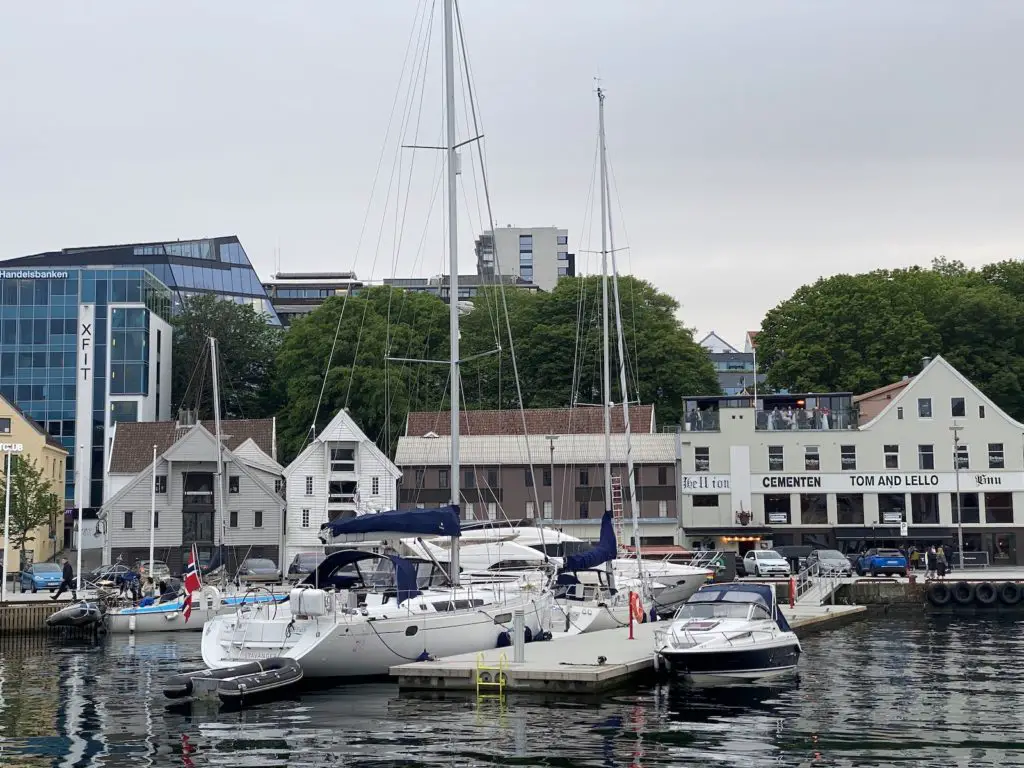
Do Catamarans Have More Space?
Since catamarans have two hulls, they are normally wider than monohulls. This gives the designers and owners the flexibility to maximize the space requirements in terms of space and function.
Vessels can be designed for either commercial or recreational uses. The additional space can serve as an advantage in both fields. In terms of recreational vessels such as yachts, the accommodation can be split up between the two hulls and can be well designed in such a manner that separate spaces can be allotted for the owner, guest, and crews with separate passages such that the path between the primary guests and the crew don’t collide.
In terms of interiors, the huge space addition can give the owners much more flexibility in choosing furniture without size restrictions and more space for additional appliances such as washers, dryers and so on which can make life on board much easier.
The deck can also house more people without the feeling of being enclosed in a closed space and for this reason, catamarans are normally used as party boats with wider deck space and more space to move around.
In terms of storage, catamarans have better storage options than monohulls as both the hulls can be utilized for different functions which not only increases the overall capacity of storage in terms of fuel , fresh water , cargo, and so on but also gives the designer an option to segregate the storage areas for different uses.
Catamarans are also now a growing trend in the fishing industry as the wide decks provide more area for the fisherman to move around without any obstructions making fishing much easier also, catamarans tend to roll less which stabilizes the vessel better than monohulls, giving more stable conditions for fishing without the risk of going aboard.
Due to the wider proportions, the spaces can also be designed in such a way so as to house tenders, jet-skis, and so on, on either of the deck spaces normally aft of the vessel mostly functioned by a small crane which can launch the vessel into the water.
Recreational activities such as swimming and diving can be performed with ease on both types of boats. On catamarans, the wide aft spaces also provide effective spacing for housing equipment and accessories such as dive tanks, telescopic staircases and so on which can serve as must-haves for similar activities.
The same can also be performed on monohulls with limitations to the width of the vessel. The wide superstructures on catamarans can also be used to house solar panels for green and renewable energy solutions which surely is going to be a great advantage in the near future.
Monohulls have the advantage of having wider compartments below the deck when compared to catamarans, as the overall width of the hull is larger than a single hull on a catamaran. This gives room for larger living spaces below the deck, which can have the option to walk around on either side of the bed.
Why Are Catamarans More Expensive Than Monohulls?
Catamarans are normally priced more than monohulls. This is because they have more overall area which requires more raw materials in the production stage than monohulls.
In terms of machinery, they have two or more engines on each hull depending on the width of each semi-hull and its supporting machinery which can increase the overall cost of the final product.
In terms of engines, maintenance is less frequent when compared to monohulls as they don’t need to operate on their maximum limits to push the vessel.
Maintenance costs can also be higher for catamarans as they have more machinery and more deck space, but on the contrary, the ease of maintenance will be much better in catamarans than monohulls as they have better accessible spaces.
The preventive maintenance for corrosion and marine growth on catamaran hulls is also higher as they normally have more area to treat than monohulls.
Are Catamarans Faster Than Monohulls?
Catamarans tend to outperform monohulls due to their slender hulls which help in reducing the drag forces. On performance power catamarans the space between the two hulls is called a “Tunnel” which is designed in a similar manner to an aerofoil so that it acts like a wing, which increases the aerodynamic lift forces thereby increasing overall efficiency and top-end speeds of the vessel.
The balance between the hydrodynamic and aerodynamic forces is the key aspect that determines the performance and stability of high-speed catamarans.
Fuel economy is normally better on catamarans due to the higher lift forces and lower water friction compared to monohulls which thereby reduces the overall load on the engines, reducing fuel consumption.
Is A Catamaran More Stable Than A Monohull?
Catamarans are generally more stable than monohulls in terms of roll stability. Let’s take an example of balancing a stick in the middle compared to balancing it by supporting the two ends, obviously, the second case has an advantage. In a similar manner, we can observe that catamarans have better roll stability when compared to monohulls.
This gives them an upper hand in terms of comfort and executing different operations onboard the vessel with ease, also reducing the risk of people falling on board the vessel. Catamarans are mostly used as ferries or passenger vessels as people tend to get less seasick on these kinds of vessels.
The deeper the deadrise the better the sea-keeping characteristics, most monohulls are designed with a deep v deadrise and tend to outperform catamarans which normally have displacement or semi-displacement hulls, in rough waters.
The typical catamarans are better in shallower water than rough water due to this reason and that’s why we see most of the coastal or inland cruisers as catamarans and most ocean-going vessels as deep v monohulls.
The draft can be defined as the distance of the waterline to the keel of the vessel. Catamarans normally tend to have a lower draft compared to monohulls which gives them an advantage of plying over shallower waters without the risk of grounding.
The lower the draft of the less the vessel, the less it is in contact with water, and therefore the overall water friction resistance is reduced leading to the need for lower power to push the vessel and better fuel efficiency.
What Is Easier To Sail A Catamaran Or Monohull?
For the thrill of sailing most sailors prefer monohulls over catamarans. They are sensitive to different forces like wind and waves acting on the vessel and there is an immediate response on the vessel. They ride through rough and choppy waves; this is the experience the sailors look forward to, giving them an adrenaline rush.
Sailing catamarans do not respond similarly to monohulls as the overall motions are reduced and also monohulls maneuver much easier than catamarans at high speeds.
Docking in marinas usually is easier with monohulls than catamarans as they require lesser space to mauver into the docking space.
Which Is Safer Catamaran Or The Monohull?
Catamarans normally tend to be on the safer side than monohulls in terms of backups and safety. If any machinery fails there is always a backup, say for example if rudder machinery fails on the port hull we can always get back ashore with the help of the starboard rudder, similarly if an engine fails there is always the second engine which can be used as a backup.
In terms of reserve buoyancy, if the port side hull gets damaged, the vessel will still remain afloat. These advantages can help people on board keeping them safe and saving a life.
The only downside to the above aspects is the maintenance costs which come up with the same as we discussed earlier.
Which One Should I Get?
The type of vessel should depend totally on your end goals in terms of functionality, performance, region of operation, and so on.
But always keep in mind never to get blinded by the length when you compare a monohull to a catamaran. A monohull in comparison might be longer but the overall space which is measured in cubic space will be higher in the shorter-length catamaran.
Going through the pros and cons the final decision should be made depending on your personal requirements.

- Recent Posts
- The Role of Cargo Ships in Global Trade – August 22, 2024
- Report: Yang Ming’s YM Mobility Explosion at Ningbo-Zhoushan Port – August 9, 2024
- Understanding Drillships: Types, Key Features and Advancements – August 1, 2024
About the author
I worked as an officer in the deck department on various types of vessels, including oil and chemical tankers, LPG carriers, and even reefer and TSHD in the early years. Currently employed as Marine Surveyor carrying cargo, draft, bunker, and warranty survey.
Latest posts

The Quality Control Process in Marine Manufacturing
Companies in the marine manufacturing space must have tight and effective quality control processes. What steps should an effective quality control process include?

The Role of Cargo Ships in Global Trade
Contents show Volume of Goods Transported by Sea Key Global Trade Routes Economic Impact of Maritime Shipping Types of Cargo Commonly Transported Environmental Considerations Conclusion Cargo ships are the lifeline […]
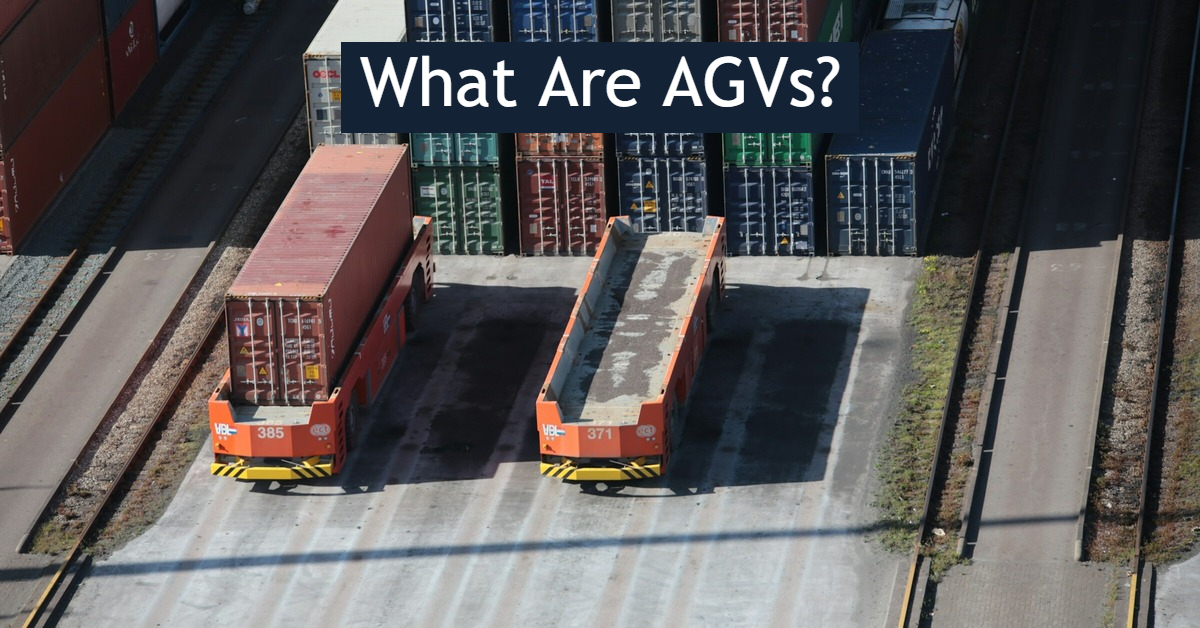
What Are AGVs? Automation Becoming Increasingly Common in Seaports
What are AGVs? Automated guided vehicles can minimize the troubles of manual operations and enhance seaport operations.

Are Catamarans Good in Rough Seas?- Expert Insights!
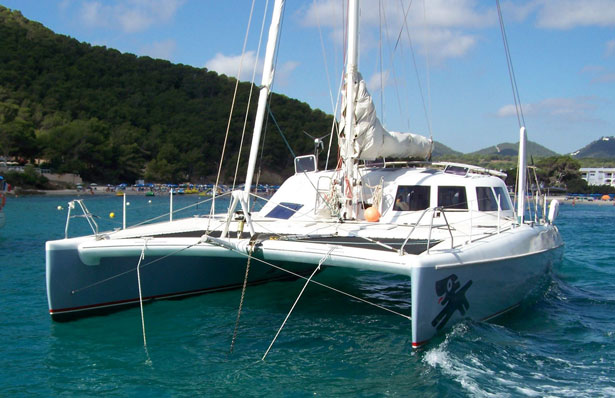
When it comes to sailing, the stability and performance of your vessel in various sea conditions are paramount. Now, if you’re curious about multihulled vessels, specifically catamarans, you might be asking yourself, are catamarans good in rough seas?
It’s a valid question, especially considering that the open waters can be unpredictable and challenging.
Catamarans, with their two hulls, offer a distinctive design that can influence how they handle when the waves get choppy and the wind picks up.
Let’s delve into the features that make catamarans a subject of interest for many sailors and explore how they measure up when the sea decides to show its wild side.
Table of Contents
Are Cats Good In Rough Sea Conditions?
Yes, catamarans are generally considered good in rough waters. They are known for their stability, which is due to their wide beam and the fact that they have two hulls. This design allows them to remain more level than monohulls, which can heel over significantly. Catamarans also have two rudders, providing additional control and maneuverability in rough seas, which means you can steer the boat more easily and avoid waves better. However, it’s important to note that while catamarans have these advantages, the safety and performance in rough waters also greatly depend on the skill and experience of the crew, as well as the specific design of the catamaran.
Are Catamarans Safer Than Monohulls In Rough Conditions?
Catamarans designed for cruising are considered safe in turbulent waters, yet they pose unique challenges compared to traditional single-hulled sailboats. Let’s see their differences and how each boat performs in rough seas.

Single-hulled vessels incorporate ballast either within or attached to the lower part of the hull. For instance, a 30-foot single-hulled sailboat may carry over a ton of lead as ballast. This significant weight at the base ensures that the vessel sways with the wind and waves but largely stays upright, similar to a pendulum that keeps the vessel balanced.
However, even the most well-crafted single-hulled boats can be tipped onto their sides in severe weather conditions. If the vessel is secured with all openings sealed and doesn’t take on water, it should right itself after rolling.
Yet, if struck by strong winds from the side, a single-hulled boat can capsize. Another risk is when a boat speeds over large waves, potentially causing the bow to plunge into the water on the other side, resulting in a pitch hole—a somersault motion of the vessel. While such incidents are uncommon, they can occur in both sailboats and motorboats.
If a boat is well-prepared for such events, with all ports and hatches sealed, it should be able to recover from capsizing, though not without potential damage to the mast, rigging, and interior. Surviving such an ordeal is possible, albeit distressing.
In the most extreme conditions, no vessel is entirely unsinkable. Yet, both large and small single-hulled sailboats have weathered severe storms, such as typhoons and hurricanes, thanks to their ballast and robust construction.
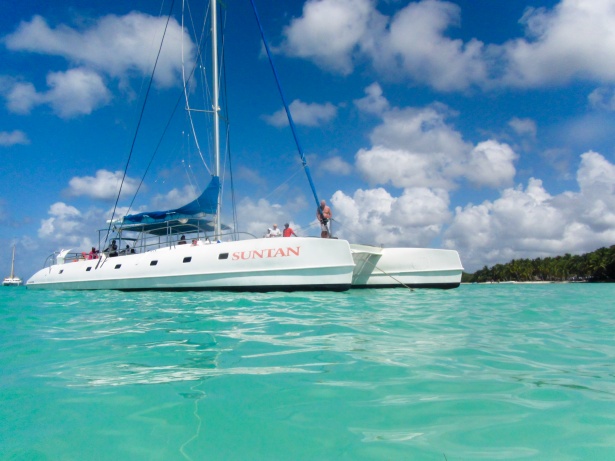
The dynamics are different with catamarans, which typically lack ballast. Instead, they rely on their broader beam for stability to stay upright. Nevertheless, in sufficiently strong winds, even the broadest catamarans can capsize, an event often understatedly referred to as “turtling.”
Racing catamarans frequently experience capsizing as part of their sailing experience. They use the crew’s weight for stability and are often sailed at steep angles. If a racing Cat capsizes, the crew can manually right the vessel by exerting considerable effort.
In contrast, large cruising catamarans cannot be easily righted once capsized, and they are not designed to sail with their hulls significantly elevated out of the water. Therefore, it’s crucial to reduce sail area early when winds intensify.
Despite being infrequent, accidents do occur, and even the largest catamarans can capsize in extremely strong winds. Additionally, catamarans tend to be faster than monohulls , which increases the risk of pitch-poling.
It is accurate that catamarans typically do not sink because they lack ballast. This implies that in the event of capsizing, your large catamaran essentially turns into a vast, albeit costly, raft, which is ironically more stable when it is upside down.
Nevertheless, the likelihood of a large catamaran capsizing is quite low, and many cruising catamarans have successfully navigated oceans under various weather conditions. With skilled handling and attentive weather monitoring, cruising catamarans can be considered just as secure as their monohull counterparts for cruising purposes.
Often Asked Questions
Q: Is it rare for a catamaran to capsize?
The stability of a catamaran varies with its size. Smaller catamarans, which often lack cabins, can capsize with relative ease, but this isn’t typically a serious issue as they can be righted without too much trouble. Larger catamarans are less prone to capsizing due to more cautious handling, as righting them once overturned is a significant challenge.
The stability of catamarans is largely due to their broad beam or the width between their dual hulls. This design feature contributes to their upright stability.
However, in the event of a capsize, this same feature ensures that they remain stable, even when flipped over. The wide beam, combined with the submerged rigging, keeps the overturned vessel steady in the water.
Q: Why Do Catamarans Capsize?
Catamarans can capsize due to a couple of main reasons:
- Pitchpoling : This is when a catamaran flips end over end, which can occur if the bows of the boat dig into the water, causing the stern to lift and flip over the bows. This is often the result of excessive speed or surfing down a wave that leads to the bows ‘burying’ into the next wave.
- Lateral Capsize : This happens due to wind action, especially when the wind hits the catamaran beam-on, and can be the biggest contributor to catamaran capsizes. It occurs if the windward force overcomes the boat’s stability, which can happen if there’s too much sail for the wind conditions or if a sudden gust hits the boat.
In both cases, managing the sail area and understanding the limits of the catamaran’s stability in varying conditions is crucial to prevent a capsize. Reducing sail in strong winds and being cautious with boat speed can help avoid your catamaran from capsizing.
Q: How do catamarans handle large waves?
Catamarans are stable but can be a bit bouncy in choppy seas because they’re usually lighter and can skip over the tops of waves rather than cut through them. This can make the ride a bit uncomfortable if the waves are coming from all directions, which is known as a confused sea state.
Another thing is that because catamarans have a wider beam, which is the width of the boat, including the space between the hulls, they can be more affected by strong winds. The wind can push on that wide area and make the catamaran harder to control.
Despite these challenges, catamarans are generally considered safe and capable in rough seas, especially if they are designed for ocean crossing. They have a lot of buoyancy , and the two hulls provide a good amount of redundancy – if one hull gets damaged, the other can help keep the boat afloat. Plus, their shallow draft, which is how deep the boat goes below the waterline, means they can avoid some underwater hazards that deeper boats might hit.
In the hands of an experienced skipper who knows how to adjust the sails and speed for the conditions, a catamaran can be a good choice for navigating through rough waters. But like any boat, it’s important to respect the sea and understand the limits of your vessel.
Final Words!
In conclusion, catamarans can be good in rough seas due to their stability, comfort, and design features that can handle challenging conditions. But like any boat, they have their limits and require a knowledgeable and attentive crew to navigate safely through rough waters. It’s always essential to respect the power of the sea and ensure that your vessel is well-maintained and your sailing skills are up to the task, no matter what type of boat you’re on.
Want More Tips?
Subscribe to Cruising Sea newsletter to receive every two weeks the latest posts straight to your inbox!

Daniella has been passionate about travel, the sea, and nature for many years. As a child, she frequently traveled throughout the Mediterranean and continued with her journeys throughout her adult life.
Her experiences have created the desire within her to share her love for traveling with other passionate and adventurers who want to discover beautiful horizons and new cultures.
Leave a Comment Cancel reply
By using this form you agree with the storage and handling of your data by this website. *
- Sailing Heavy Weather: Yacht vs. Catamaran - Choosing the Right Vessel for Rough Seas
When it comes to sailing, one of the most exhilarating experiences is navigating through heavy weather. The clash of wind and waves, the challenge of maintaining control, and the thrill of conquering the elements make it an adventure like no other. However, choosing the right vessel can significantly impact your safety and comfort during such conditions. In this comprehensive guide, we will explore the differences between yachts and catamarans when it comes to sailing in heavy weather. Whether you're a seasoned sailor or a novice, understanding the advantages and disadvantages of each vessel will help you make an informed decision.
Yacht vs. Catamaran: The Basics
Yachts are known for their elegance and traditional design. They are single-hulled vessels with a deep keel that provides stability in calm waters. However, when it comes to heavy weather, yachts have some limitations:
- Less Stability : Yachts have a narrower beam, which makes them less stable in rough seas.
- Heeling : Yachts tend to heel or lean to one side in strong winds, making them more challenging to control.
- Slower Speed : Yachts are generally slower than catamarans, which can be a disadvantage when trying to outrun a storm.
Catamarans, on the other hand, have gained popularity for their unique design and superior performance in various conditions. Key advantages of catamarans in heavy weather include:
- Stability : Catamarans have a wider beam, which provides excellent stability, reducing the risk of capsizing.
- Reduced Heeling : Catamarans remain level even in strong winds, offering a more comfortable sailing experience.
- Speed : Catamarans are faster due to their twin-hull design, allowing you to navigate heavy weather more efficiently.
Sailing a Catamaran in Heavy Weather
If you've chosen a catamaran for your heavy-weather adventures, it's essential to understand some essential tips and techniques:
1. Reef Early
When you see dark clouds or feel the wind picking up, reef your sails early. Reduce the sail area to maintain control and prevent capsizing.
2. Keep a Close Eye on the Weather
Stay updated with weather forecasts. Modern technology and apps make it easier than ever to monitor changing conditions while at sea.
3. Maintain Speed
Catamarans thrive on speed. Keep moving forward to maintain control. Avoid pointing directly into the wind, as this can lead to a capsize.
4. Balance the Load
Distribute weight evenly to ensure the catamaran remains balanced. This is crucial for stability during heavy weather.

5. Practice Seamanship
Learn and practice seamanship skills, including handling waves, steering techniques, and emergency procedures.
Catamaran for Sale: Finding the Right One
If you're considering purchasing a catamaran for heavy-weather sailing, you'll find various options on the market. Here are some tips for finding the perfect vessel:
1. Budget-Friendly Options
Explore catamarans for sale in the Caribbean if you're looking for affordable options. The region offers a wide range of choices at competitive prices.
2. Performance Matters
Consider a performance catamaran for sale if you plan to sail in challenging conditions frequently. These vessels are designed for superior speed and stability.
3. Size Matters
Choose a catamaran size that suits your needs. Smaller models are more manageable for solo sailors, while larger ones offer more space for crew and equipment.
Heavy Weather Sailing: Yachts vs. Catamarans
Now that we've covered the basics let's delve deeper into the comparison between yachts and catamarans in heavy weather sailing.
Yachts in Heavy Weather
1. hull design.
Yachts typically have a monohull design with a single, deep keel. While this design provides stability in calm waters, it can be a disadvantage in heavy weather. Yachts are prone to heeling, where they lean to one side in strong winds. This heeling can be uncomfortable for passengers and challenging for the crew to manage.
2. Capsizing Risk
Due to their single-hull design, yachts have a higher risk of capsizing in heavy weather. When hit by a strong gust of wind, a heeling yacht can reach a critical angle of heel, leading to a potential capsize. This risk necessitates vigilant seamanship and early reefing of sails when sailing a yacht in heavy conditions.
3. Speed and Maneuverability
Yachts are generally slower than catamarans, which can be a disadvantage when trying to outrun or navigate through a storm. Their deeper keel design may limit their ability to sail in shallower waters, reducing their maneuverability.
Read our top notch articles on topics such as sailing, sailing tips and destinations in our Magazine .
Check out our latest sailing content:
Catamarans in heavy weather, 1. stability.
Catamarans are known for their stability in heavy weather. Their twin-hull design provides a wider beam, making them less prone to heeling. This stability offers a more comfortable and secure experience for passengers.
2. Reduced Heeling
Unlike yachts, catamarans remain level even in strong winds. This reduced heeling minimizes the risk of items falling and passengers feeling seasick. It also makes it easier for the crew to maintain control of the vessel.
3. Speed and Efficiency
Catamarans excel in heavy weather due to their speed and efficiency. Their twin-hull design allows them to slice through rough seas with less resistance. This speed can be crucial when trying to outrun or navigate through storms, improving safety and comfort.
Sailing a Catamaran in Heavy Weather: Advanced Techniques
As you gain experience in heavy weather sailing with a catamaran, you can explore advanced techniques to enhance your skills and safety:
6. Use Storm Sails
Invest in storm sails specifically designed for heavy weather conditions. These smaller, more robust sails are easier to control and maintain stability.
7. Master Reefing
Perfect the art of reefing your sails quickly and efficiently. Proper reefing is crucial for maintaining control and preventing over-pressuring the rigging.
8. Learn Heavy Weather Navigation
Study advanced navigation techniques for heavy weather conditions. This includes understanding wave patterns, currents, and strategies for avoiding dangerous areas.
9. Emergency Procedures
Familiarize yourself with emergency procedures such as man overboard drills, deploying sea anchors, and abandoning ship protocols. Being prepared for the worst-case scenario is essential for safe heavy weather sailing.
Catamaran for Sale: What to Look For
When searching for the ideal catamaran for heavy weather adventures, consider these additional factors:
4. Seaworthiness
Ensure the catamaran you choose is designed for seaworthiness. Look for features such as reinforced hulls, robust rigging, and watertight compartments for added safety.
5. Accommodation
Consider the number of cabins and the layout of the catamaran. Adequate accommodation is essential for comfort during extended heavy weather voyages.
6. Equipment and Safety Features
Check for essential equipment such as life rafts, EPIRBs (Emergency Position-Indicating Radio Beacons), and other safety features. These can be lifesavers in case of emergencies.
Sailing in heavy weather can be both a challenge and an adventure. Your choice between a yacht and a catamaran significantly impacts your experience. While yachts offer elegance and tradition, catamarans provide stability and speed, making them a popular choice for adventurous sailors. Remember to practice safe seamanship, stay informed about weather conditions, and continually improve your skills to ensure a successful voyage.
So what are you waiting for? Take a look at our range of charter boats and head to some of our favourite sailing destinations.
I am ready to help you with booking a boat for your dream vacation. Contact me.

Denisa Nguyenová
- Travel Resources
- Destination Inspiration
- Tips & Advice
- Did You Know?
- Conservation

- Action & Adventure
Are Catamarans Safe in Rough Seas?
- January 13, 2021

Trying to sail any boat in rough seas will take a lot of effort, even with these catamarans . Several factors work together to keep you safe should you encounter a gale or choppy waters. Fortunately, modern catamarans have seen significant improvements that make them safer than ever before in rough seas.
Modern Catamaran Improvements
Today, there are two main types of catamarans you might find yourself on, one being charter or cruising catamarans, and the other is high-performance.
As you can likely tell, the high-performance models are bound to be substantially better in rough seas and give you the ability to outrun poor weather. These days boat fitters are always improving the spec on all types of boats especially catamarans. However, they can also be challenging for beginners since they’re designed for higher speeds.
Charter or Cruising Catamarans
If you’ve recently been on vacation, you’ve likely seen a charter catamaran or hybrid catamarans . These boats are specifically designed for charter cruises and often feature low-aspect rudders, fixed keels, and high-wind flybridges. They also have significantly heavier displacement as well as shorter bows.
Charter catamarans can be challenging to use at high speeds, even if you’re navigating on flat water. When traveling windward, they’re ideal for close-hauled sailing at up to 60-degree angles.
If you were to encounter rough seas in these boats, there are two main concepts to remember: maintain control and speed. You won’t want to pick up too much speed because it can be more challenging to control. It could also endanger both the crew and the boat, which is why they’re not ideal for choppy conditions.
High-Performance Catamarans
These boats are designed with special techniques that make them ideal for traveling at higher speeds. They feature rudders deeper than charter models, which also creates less displacement and windage.
Another benefit is that they have highly efficient centerboards and daggerboards. When sailing, you’ll notice high-performance models can outsail nearly any keelboats while traveling windward.
In addition to their impressive speeds, they are also known to be more lightweight, making them easier to maneuver. If you’re caught in rough seas in a high-performance catamaran, you’re more likely to navigate through the storm successfully.
Not only will you be able to manage the storm conditions securely, but you could also outrun inclement weather. By maintaining your balance while using lower loads and traveling at higher speeds, you can be safe.
How To Handle Catamarans in Rough Seas
Let’s say you’re stuck in a situation where you have no choice but to sail through rough seas with your catamaran. Consider these tips because they could significantly improve your chances of a safe return to port.
Reading the Sea Room
Having a good idea of the sea room can give you the information you need to navigate the boat safely. You’ll be able to determine the appropriate speed to sail with the sea, allowing you to maintain the most control.
Depending on the conditions, you have to determine whether slowing down or speeding up is ideal. Remember, drogue slows the catamaran down while the sea anchor is best for mooring with minimal drift. The more effective you are at moving with the sea, the less stress the boat will experience.
Opting for Downwind Travel
When sailing in heavy seas, consider sailing at a slight angle because it improves the boat’s sufficient length. The catamaran will have access to diagonal distance, which is longer than the boat’s total length. The more length you have access to, the easier it will be to follow the sea.
Another important aspect of taking advantage of diagonal distance is that it keeps your hull stable. With the proper angle, pitchpoling is far less likely, and the bows won’t bury as much.
Using Minimal Sail
One of the most important factors to consider is the amount of sail you should be using when you encounter rough conditions. Sailors most often prefer to use minimal sail since it calms the catamaran and allows the boat to autopilot easier.
By encouraging non-yawing and vertical rudders and keels, the boat will find it easier to handle the brunt of navigation.
The Advantages of Catamarans in Rough Seas
There is an incredible number of myths about catamarans, especially among monohull owners. These boats are one of the superior options for tackling rough seas, especially with anglers. A few essential advantages to note are:
High-Speed Sailing
The higher speeds of performance catamarans have made them a popular topic of discussion among Naval scientists . Their hull energy allows sailors to travel extensive distances in a limited amount of time. With this amount of power, you can quickly navigate through heavy waters or avoid them entirely.
Added Stability
One of the primary reasons to consider a catamaran for rough seas is its inherent stability. They are often preferred for families and senior sailors who find it tough to find their sea legs. The boat’s size and design make it far less susceptible to wave action, especially compared to a monohull.
Reduced Seasickness
Becoming seasick can disrupt your entire trip on the water, which is another reason to consider catamarans. With their improved stability, you’ll feel far less motion aboard a catamaran than other boats. There’s far less rocking and rolling, which makes it a more comfortable experience for everyone.
Impressive Buoyancy
For as large as they are, catamarans are ideal for their buoyancy. Since they aren’t designed with a lead-filled keel, your boat will float even if it’s holed. Some of the more modern high-performance catamarans are so buoyant; they’re relatively impossible to sink.
Catamarans are safe to navigate in rough waters, as long as you can maintain control of the craft. They have remarkable buoyancy, inherent stability, and high speeds to outrun inclement weather.
Related Topics
- are catamarans safe in rough seas
- sailing holidays
Vacationing in Colorado

Qualities to Look For in a Trailer
- January 14, 2021
You May Also Like

Embarking on Epic Camping Journeys: Unforgettable Camping Adventures
- September 8, 2024

How to Prepare for a Golf Vacation
- September 6, 2024

Experience the Charm of Skiing in Megève: Your Guide to Ski Lessons and More
- September 4, 2024

Golf Travel in Australia: Luxury on a Budget
- September 2, 2024

PureTravel Activity Guide: Whale Watching
- August 26, 2024

Take the Leap: Everything You Need to Know About Tandem Skydiving
- August 21, 2024

A Guide to Backpacking Holiday in Japan
- August 18, 2024

How to Plan Your Next Fishing Trip
- August 7, 2024
Input your search keywords and press Enter.

FREE CANCELLATION & RESCHEDULING 2024
+385 21 55 33 01 +385 91 3000 009
+385 91 3000 009
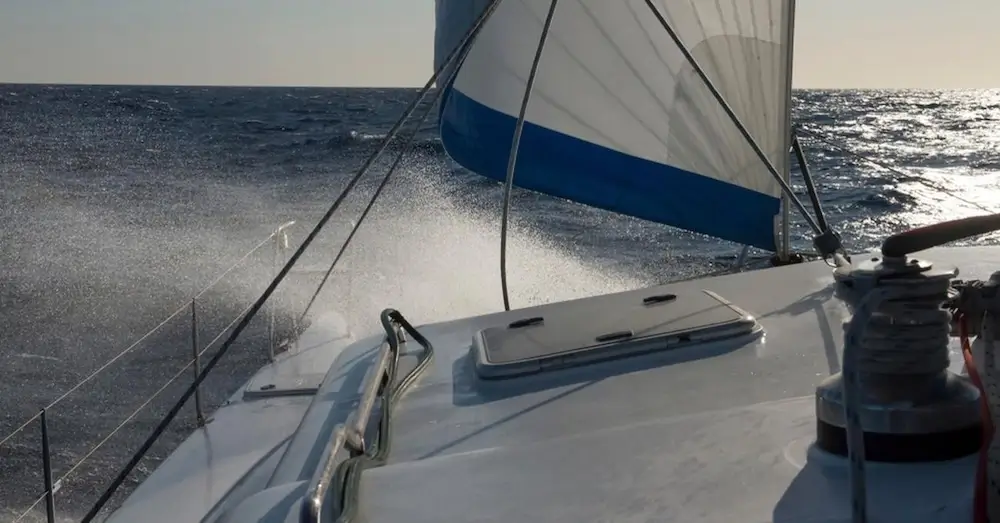
Are Catamarans Safe in Rough Seas?
Introduction: setting sail in greece.
Embarking on a Greece yacht charter adventure is a dream for many sailors. The azure waters of the Aegean and Ionian Seas beckon with their beauty and promise of idyllic sailing conditions. But even in this Mediterranean paradise, weather can be unpredictable, and rough seas are not uncommon. This raises an important question for those considering a yacht rental in Greece: Are catamarans safe in rough seas?
Understanding Catamaran Design
Dual hulls: stability and comfort.
The most distinct feature of a catamaran is its two hulls, which provide a wider base and more stability than traditional single-hulled vessels. This design minimizes rolling and can make for a more comfortable experience, especially in choppy conditions.
Weight Distribution and Buoyancy
Catamarans are designed to distribute weight evenly between the two hulls. This buoyant structure can offer advantages in rough water, contributing to its ability to handle waves differently than monohulls.
Catamarans vs. Monohulls: A Comparative Safety
Stability in waves.
The dual-hulled catamaran is often lauded for its stability. In rough seas, a catamaran’s broader beam can prevent excessive heeling, which might reassure those aboard.
Maneuverability Concerns
A catamaran’s wider shape can sometimes affect its maneuverability in tight situations. Skippers need to be adept at handling these vessels, especially in the unpredictable Greek waters.
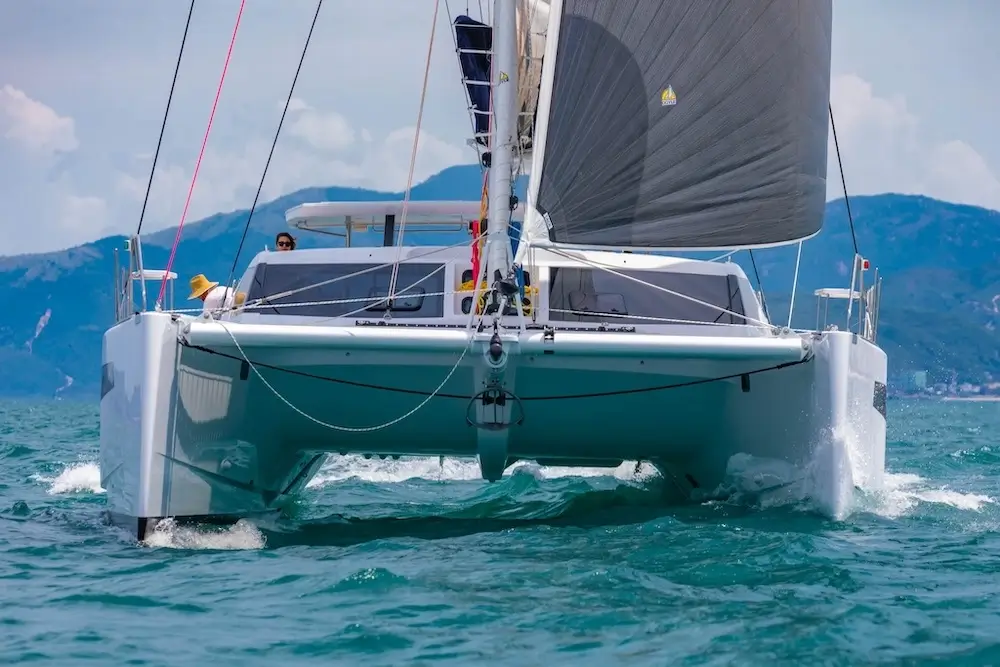
Are Catamarans Safe In Rough Seas 2
The Role of Skipper Experience
The importance of a seasoned skipper.
When chartering a catamaran, especially in areas where rough seas are possible, the experience of the skipper is paramount. A knowledgeable skipper, familiar with local conditions and catamaran handling, can significantly enhance safety.
Skipper Training and Certification
In Greece, skippers must be certified and are often seasoned sailors with extensive knowledge of the local seas. This is an essential factor in ensuring safety on a catamaran.
Weather in Greece: A Crucial Factor
Understanding local weather patterns.
The weather in Greece can vary greatly from one region to another. Knowledge of local weather patterns is crucial when sailing, especially in a catamaran, which may be more sensitive to certain weather conditions.
Seasonal Considerations
Different seasons bring different sailing conditions. In summer, the Meltemi winds can create challenging conditions for sailors. Understanding these patterns is critical for planning a safe journey.
Construction and Design Innovations
Modern catamarans: built for rough seas.
Over the years, catamaran design and construction have evolved. Modern catamarans are built with rough seas in mind, incorporating features that enhance their seaworthiness.
Safety Features
From advanced navigation systems to reinforced hulls and automatic reefing systems, contemporary catamarans are equipped with numerous safety features that make them better suited for challenging conditions.
In the next section, we’ll delve deeper into how catamarans handle rough waters, including insights from seasoned sailors, safety protocols, and key features that contribute to a catamaran’s performance in unpredictable seas. We’ll also explore the allure of catamaran charters in Greece and how to ensure a safe and memorable sailing experience amidst the stunning Grecian landscapes.
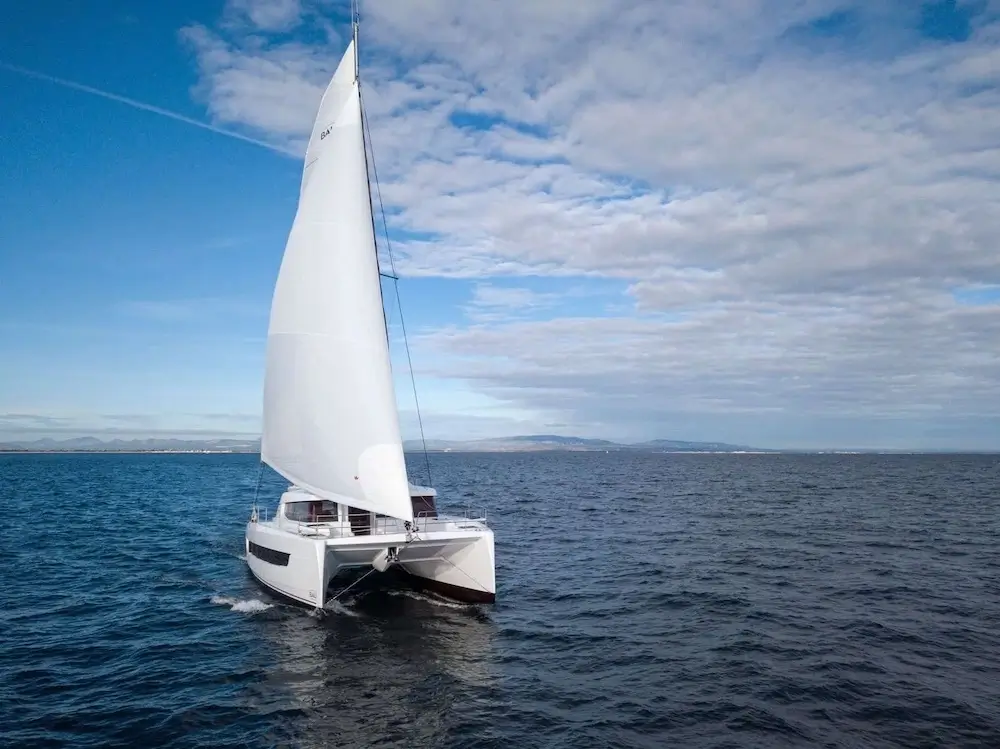
Are Catamarans Safe In Rough Seas 3
Navigating Rough Seas: Catamarans at the Helm
The dynamics of catamaran sailing in turbulent waters.
Understanding how a catamaran reacts to high waves and strong winds is crucial for safe navigation. Its wide stance on the water can make for a smoother ride over waves, reducing the risk of capsizing compared to traditional monohulls.
Safety Measures in Design
Modern catamarans are designed with safety as a priority. Many models come equipped with safety nets, handholds, and guard rails. The redundancy of having two engines and two rudders adds an extra layer of security.
Advanced Technologies Enhancing Safety
Gps and autopilot systems.
The integration of GPS and advanced autopilot systems has made it easier to navigate and maintain course in rough conditions, a boon for catamaran charters in Greece.
Communication and Safety Equipment
EPIRBs, VHF radios, and other communication devices are standard on catamarans, ensuring that help can be reached in case of an emergency.
Catamaran Charter in Greece: Preparing for the Sea
Choosing the right catamaran.
When planning a catamaran charter in Greece , selecting a vessel that matches the sailor’s experience level and the expected sea conditions is crucial.
Pre-Departure Checks and Briefings
Before setting sail, comprehensive checks and thorough briefings on the specific catamaran’s operations and emergency procedures are essential.
Handling Emergencies at Sea
Drills and protocols.
Regular drills and a clear understanding of emergency protocols can make a significant difference in response times and outcomes should a situation arise at sea.
Medical Kits and Life Rafts
Ensuring that medical kits are fully stocked and life rafts are in working order is non-negotiable for any seafaring vessel, particularly in a catamaran facing rough seas.
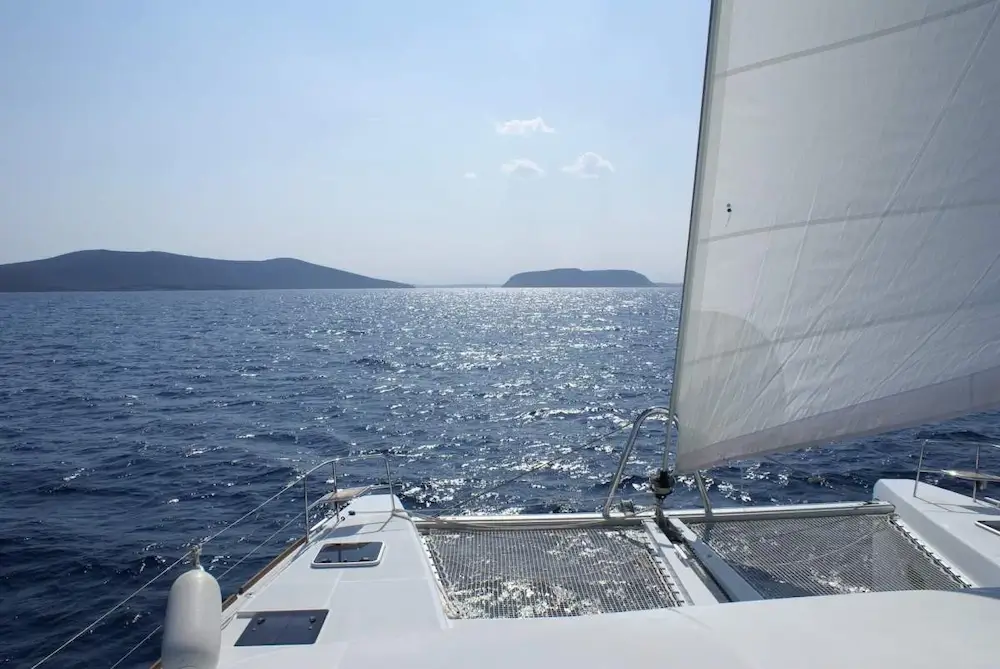
Are Catamarans Safe In Rough Seas 4
Catamaran Sailing Techniques in Adverse Weather
Reefing the sails.
Knowing when and how to reef the sails is a critical skill for maintaining control of a catamaran in high winds.
Navigating Waves
The approach to navigating waves can differ between catamarans and monohulls. Skippers must be adept at reading the sea and using the catamaran’s design to its advantage.
Case Studies: Catamarans Weathering the Storm
Real-life incidents and learnings.
Analyses of real-life incidents where catamarans have faced severe weather conditions can provide invaluable insights into their sea-keeping capabilities.
Testimonies from Experienced Skippers
Skippers who have helmed catamarans in rough seas offer a wealth of knowledge and practical advice on safety and handling.
Ensuring Your Safety: Tips and Tricks
Pre-sail weather briefing.
Always start with a comprehensive weather briefing. Understanding the forecast can prevent being caught off-guard by rough conditions.
Life Jackets and Personal Locator Beacons
The use of life jackets and personal locator beacons is mandatory for each crew member at all times during rough weather sailing.
Continuous Monitoring
Keep a continuous watch for weather changes and be prepared to adjust your sailing plan accordingly.
The Final Verdict on Catamaran Safety
Weighing the benefits and risks.
When deciding between a catamaran and a monohull, it’s essential to weigh the inherent safety features of catamarans, such as stability and shallow draft, against potential risks like beam seas and windage.
Safety: A Shared Responsibility
It’s not just about the type of boat but also about the skills of the skipper and crew. Safety is a collective responsibility that involves preparation, knowledge, and respect for the sea.
The Role of Modern Equipment
With advancements in nautical technology, catamarans are equipped with state-of-the-art navigation systems, making them safer and easier to handle even for novice sailors.
Preparing for the Unexpected
Safety drills: not just a formality.
Conducting regular safety drills is more than a formality; it’s a practice that could save lives, ensuring everyone knows how to act if the unexpected happens.
The Skipper’s Experience
A seasoned skipper’s experience is invaluable, particularly in rough weather. Hiring a skilled skipper can significantly enhance the safety of your yacht charter Greece .
Final Thoughts on Catamarans and Safety
Safety is no accident.
Safety on a catamaran, as with any vessel, is the result of careful planning, good design, and competent seamanship.
Choosing the Right Charter
For those looking to charter a catamaran, choosing a reputable company that prioritizes safety and provides comprehensive briefings is critical.
Conclusion: Sailing with Confidence
Embarking on a sailing holiday aboard a catamaran can be a thrilling and safe experience. Whether you’re cruising the calm waters of the summer or braving the more spirited winds of the off-season, catamarans have proven to be reliable companions on the sea. With their spacious design, enhanced stability, and modern safety features, these vessels are more than capable of providing a secure environment for seafarers. However, it’s the combination of a well-maintained boat, a knowledgeable crew, and vigilant preparation that ensures the highest levels of safety. By understanding the dynamics of catamarans in rough seas, taking proactive safety measures, and learning from seasoned professionals, sailors can enjoy the azure waters of Greece with peace of mind.
Related Posts

Which Greek islands are recommended for first-time visitors?
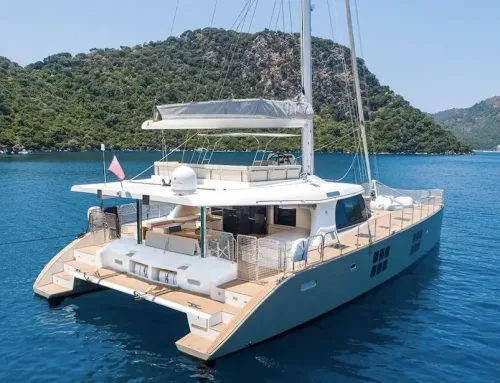
How do I choose the right catamaran for my needs?
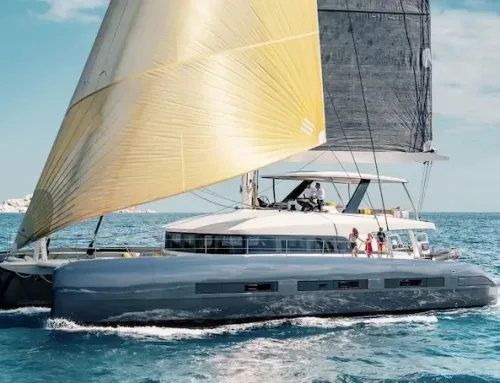
Is there a minimum or maximum rental period for a catamaran in Greece?

IMAGES
VIDEO
COMMENTS
Catamarans are safe in rough seas because their double-hull design and wide stance make them highly stable. They’re also easy to maneuver, have shallow drafts, and high speeds that help them outrun storms.
Catamarans are more stable in rough seas because they have two hulls instead of one. This means that they are less likely to roll or heel, which can make for a more comfortable ride. Monohulls, on the other hand, tend to pitch and roll more in rough seas.
Some of the best catamarans for rough seas are Leopard 53, Magnum 46, Catana 53, Heliotrope 48, Lagoon 78, and 70 Sunreef. They all feature high performance to outrun heavy weather, have wide beams for added stability, low windage designs, and enough bridgedeck clearance to prevent pounding.
Power catamarans are good in rough waters particularly because of their multi-hull design. Their wide base makes them stable, and their high speed allows for outrunning bad weather. Power cats that feature a high bridge clearance, will handle rough waters effortlessly.
Yes, catamarans are good in rough water. One of the reasons for this is that boaters have the option to steer from the inside during bad weather. What's more; the size, bridge, and bridge clearance all contribute to catamarans being a joy to drive when the water conditions are less than ideal.
The typical catamarans are better in shallower water than rough water due to this reason and that’s why we see most of the coastal or inland cruisers as catamarans and most ocean-going vessels as deep v monohulls. The draft can be defined as the distance of the waterline to the keel of the vessel.
Catamarans designed for cruising are considered safe in turbulent waters, yet they pose unique challenges compared to traditional single-hulled sailboats. Let’s see their differences and how each boat performs in rough seas.
Catamarans excel in heavy weather due to their speed and efficiency. Their twin-hull design allows them to slice through rough seas with less resistance. This speed can be crucial when trying to outrun or navigate through storms, improving safety and comfort.
One of the primary reasons to consider a catamaran for rough seas is its inherent stability. They are often preferred for families and senior sailors who find it tough to find their sea legs. The boat’s size and design make it far less susceptible to wave action, especially compared to a monohull.
Explore the safety of catamarans in rough seas. Get expert tips for a secure Greek sailing adventure, ensuring a confident charter experience.